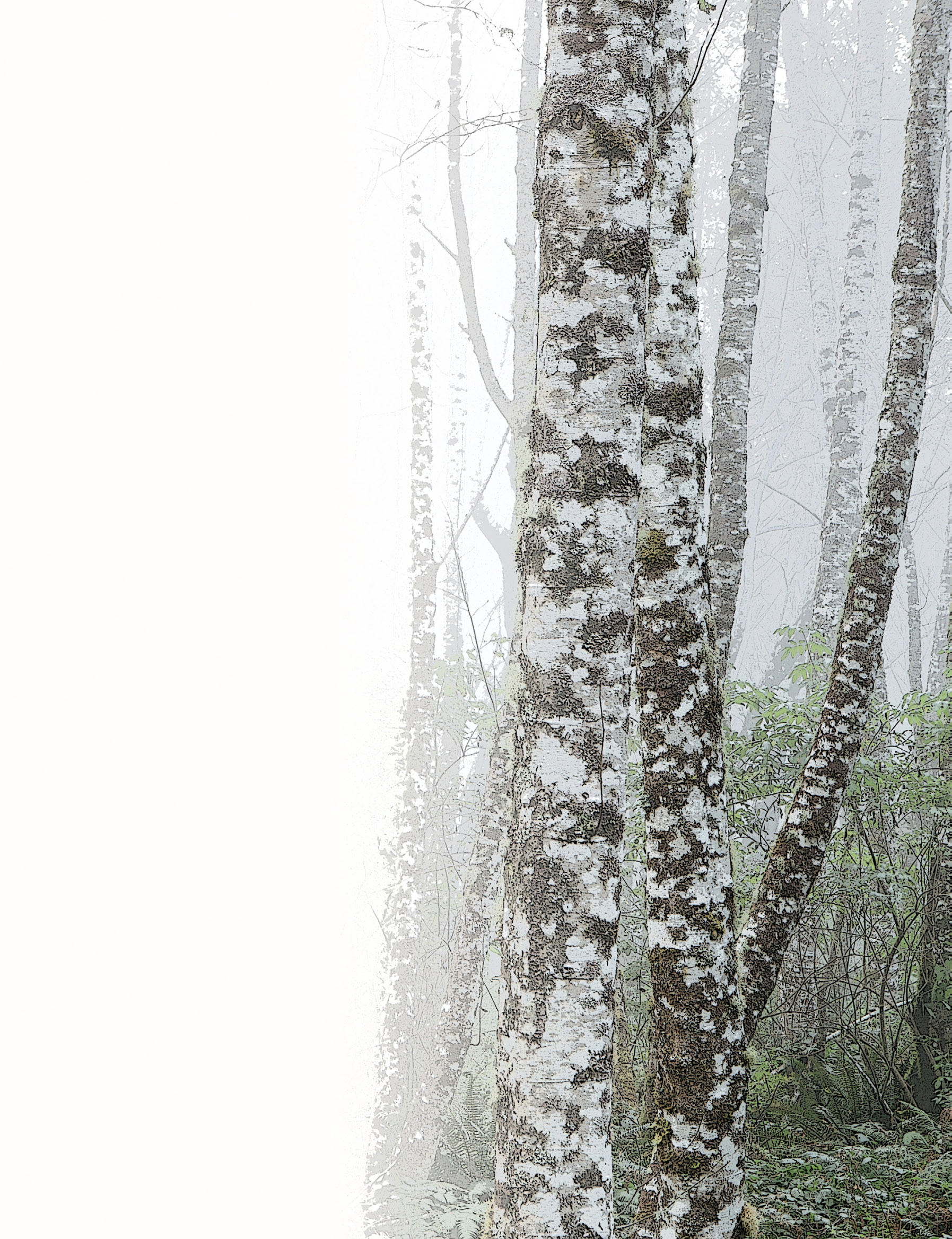
Mykyta Peregrym
A Birch
Memory
Web

PLANT PERSPECTIVES - 2025: 182–194
doi: 10.3197/whppp.63876246815895
Open Access CC BY 4.0 © The Author
ABSTRACT
This narrative non-fiction essay explores the profound and intricate connections between personal memories and birch trees throughout the author’s life. Set against the backdrop of various significant locations, from the Soviet Union and Ukraine to Finnish Lapland, the narrative intertwines the author’s childhood experiences, family history and adult reflections. Birch trees serve as poignant symbols of continuity and resilience amidst the backdrop of political and personal upheavals. The essay delves into how these trees evoke strong emotions and memories, highlighting their unique role as carriers of individual and collective histories. By examining the interplay between nature and memory, the author offers a deeply personal perspective on the importance of preserving natural environments not just for their ecological value but also for their capacity to hold and evoke human experiences.
KEYWORDS
trees, emotional connection, personal history, biodiversity
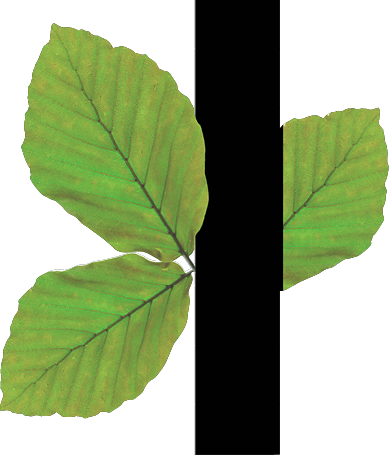 am a 44-year-old scientist. I have never been so far north, but today I find myself in a small village, Äkäslompolo, located in Finnish Lapland. Unlike other places, where islands of nature are found among the flows of people and infrastructure, here, a human still feels like a guest among endless forests and swamps (Figure 1). I am sitting on the floor of a wooden house, holding a birch leaf in my hand. I just selected it from an envelope containing many similar leaves, as instructed by the leader of retreat workshop on writing about trees and memory. While the other participants were doing the same, my mind quickly identified the species as Betula pendula. Perhaps this is my professional inclination as a botanist with over twenty years of experience, where I automatically try to identify the species of plants before appreciating their beauty, smell or other qualities.
am a 44-year-old scientist. I have never been so far north, but today I find myself in a small village, Äkäslompolo, located in Finnish Lapland. Unlike other places, where islands of nature are found among the flows of people and infrastructure, here, a human still feels like a guest among endless forests and swamps (Figure 1). I am sitting on the floor of a wooden house, holding a birch leaf in my hand. I just selected it from an envelope containing many similar leaves, as instructed by the leader of retreat workshop on writing about trees and memory. While the other participants were doing the same, my mind quickly identified the species as Betula pendula. Perhaps this is my professional inclination as a botanist with over twenty years of experience, where I automatically try to identify the species of plants before appreciating their beauty, smell or other qualities.
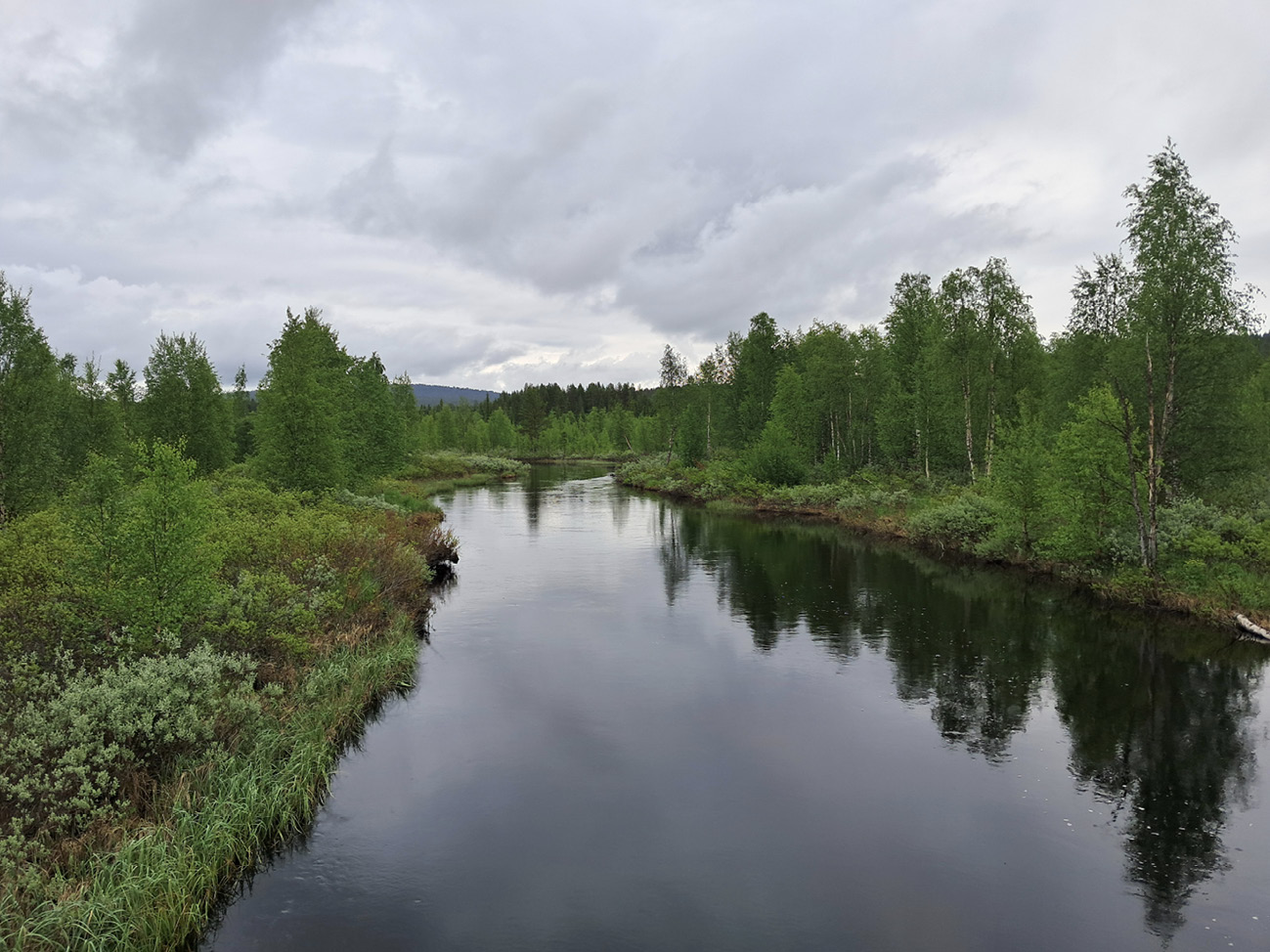
Figure 1.
Finnish Lapland near Äkäslompolo village (8 June 2024). Photo by author.
Next, our facilitator asks us to consider our leaves attentively, to touch and twist them. I do not see anything special in my green leaf, though it is larger compared to the others I saw in the envelope. Its sides are not equal; the right side is clearly bigger than the left. Additionally, the second-order veins of my leaf are not symmetrical, although in almost any botanical book, these veins always appear to start from the same place on the central vein. This is absolutely surprising to me because I have never paid attention to this detail in nature: I mean the correspondence of book illustrations with the real fact, in terms of where the veins of the leaf begin and how they are arranged. We then exchange our leaves and do the same, examining each new leaf in our hands. In these new leaves, the situation with the veins is similar to what I had observed in my own leaf.
The next group of questions from our facilitator concerns our views on the possibility that trees preserve our memories. With my practical mind, I do not dwell on the philosophical aspects of this task. Instead, I seek answers grounded in my understanding of the world’s structure. For me, there is no doubt that trees indeed are keepers of memories. This memory is stored in their tree rings, showing us, for example, which winters were especially cold and when they were very warm. Additionally, trees have individual memories in the form of injuries from blows or frost damage. Also, by analysing their DNA, we can find out what evolutionary path they followed or how they have migrated around the planet as a result of climate change. To me, this is all irrefutable.
We continue observing our birch leaves, and many of us record our impressions in our notebooks and mobile phones. Some are trying to draw their leaves, while others are simply tracing their contours. When we finish, I decide to place my leaf in my notebook, preserving it as part of my herbarium. However, I can already hear new questions from the workshop leader, and they are personal in nature. We are asked to remember when we first saw a birch tree in our lives, what we especially remember about it, and similar things. Honestly, I can barely hear the facilitator’s voice now, as I have plunged deeply into a web of memories. This brings up a sudden wave of my psychological trauma. My vision is blurring and losing focus. It seems that I have lost control over my body. At the very least, I no longer care what happens to it. But I feel that I am on the verge of tears...
My memories take me back to a time when I was very young, perhaps four or five years old. I stand on the sofa, gripping its back, peering through the veranda window at two green birch trees that line the street in front of my grandparents’ house. It’s the Soviet Union, in a small mining village near the Zapadnaya mine in Donetsk, Rostov region, Russian Soviet Federative Socialist Republic. This house and its garden were my entire world back then. I was not aware of the realities of the totalitarian state. They said on TV and radio that everything was fine, and Soviet athletes delighted in their victories and records. There were also quite a few songs. Most of them were loud, cheerful, energetic, life-affirming, only occasionally with a drop of sadness or romanticism. Of course, a significant part of them were about communists or Komsomol members building a better world by sacrificing themselves.
Though I missed my parents, who came to us from Voroshilovgrad only on weekends, my grandmother cared for me devotedly and fed me delicious meals. My favourite dish was her boiled rice with pork and onion gravy. It was a relatively simple dish that I tasted many times later in canteens or when visiting friends or relatives, but no one could cook it as deliciously as my grandmother. She also often baked crumpets, which I enjoyed eating with a variety of homemade jams made from raspberries, strawberries, apples, pears, currants and cherries, washing them down with compote made from fresh fruits that were available in our yard, as well as a sprig of mint. I do not know why, but when grandma cooked, she often grumbled, especially at grandpa. So cooking time was not the best for communicating with her.
The aforementioned birch trees were our pride. My grandfather had acquired them long ago, making our yard distinctive (Figure 2). In the steppe where Donetsk is located, birch trees are uncommon, but they thrived near our home. Their white bark distinguished them from the other ornamental and fruit trees in the area. In the summer, their long drooping branches swayed in the wind and, in the fall, the leaves turned bright yellow. I especially liked when they formed catkins, which in my native language are called ‘earrings’, because of the similarity of their forms to chain earrings. This was so unusual compared to other trees. Birch catkins appeared in the summer, overwintered until spring, and then, with the onset of warm weather, opened up to reveal yellow anthers.
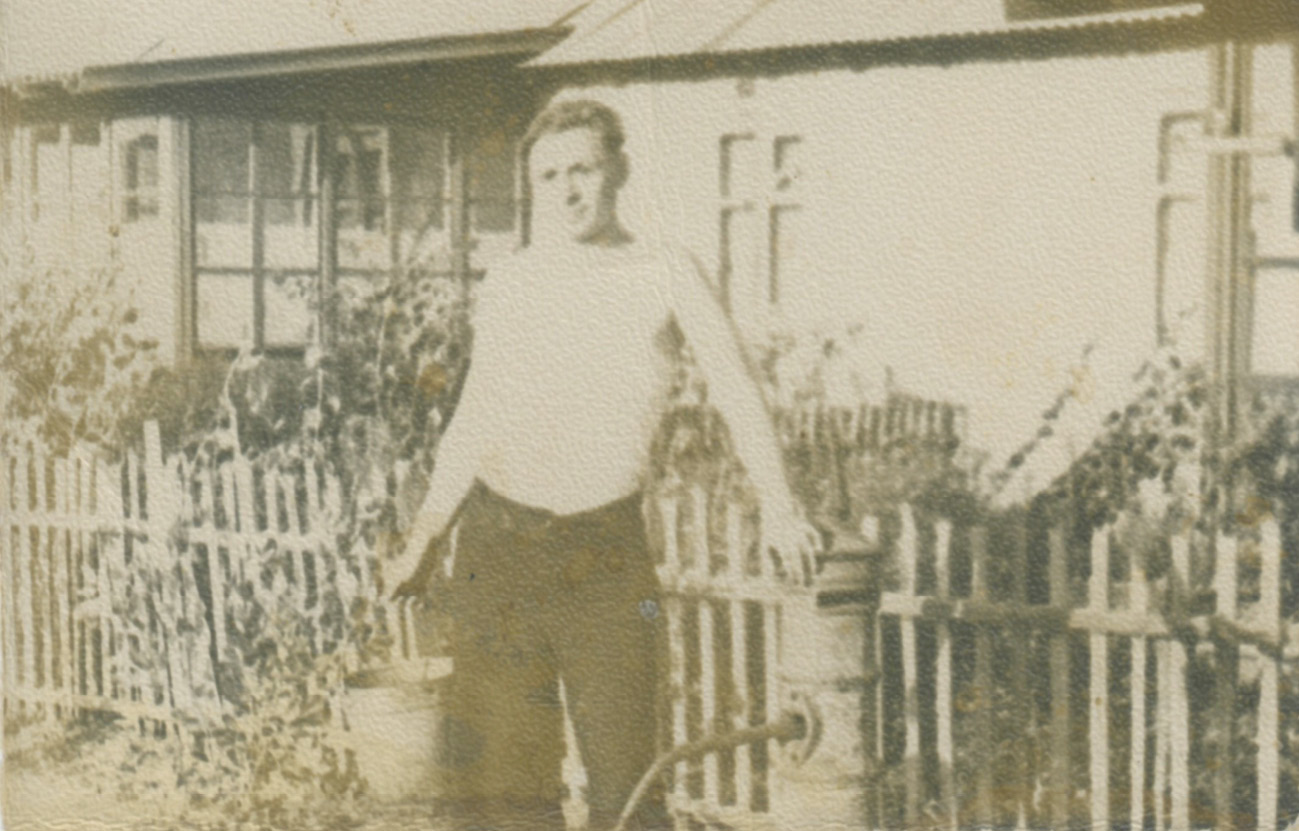
Figure 2.
Author’s grandfather near his house in Donetsk (1960’s). Though already planted, the birch trees are not visible here, they grow in front of the house, to the right of grandfather. (Author’s collection).
I recall one early spring when a truck from the mine brought us several tons of coal to heat the stove in the house. As it was being unloaded, the truck caught several branches of one birch tree, severely damaging the bark. A few days later, as soon as it got warmer, sap began to issue from these wounds. Its flow was so strong that a small puddle formed on the asphalt where it dripped. I was very concerned, perceiving it as if the tree were losing blood. Even though the tree could have dried out because of this, everything worked out. The birch continued to grow, making us as happy as before.
I do not know why my grandfather chose birch trees to plant near our house. Perhaps they reminded him of his homeland, the village of Malygino in the Pskov region, where these trees were common. When he died, I was 22 years old and had just moved to Kyiv. Gradually, our birch trees began to dry out. I do not remember the exact chronology, but about ten years later, when my childhood home was sold and my grandmother moved to live with my parents in Luhansk, the new owners cut down the almost withered trees.1 This fact was not only terrible for me, but also quite symbolic. It was like the final point in the story of my beautiful childhood. Yet, in my memory, they continue to live, their branches still swaying in the wind, and I visit my lovely grandparents in the house of my childhood over and over.
For a moment, I am taken back from my childhood memories to our retreat, where something is happening, but the energy of my memories is so strong that I am unable to focus. My consciousness is again carried away from Finnish Lapland, thousands of kilometres to distant and familiar lands. Now I am in the village of Verkhnya Orikhivka, or Dobryanka, as the locals call it. I am 12 or 13 years old. The Soviet Union no longer exists; we live in a newly independent Ukraine. My grandparents, whom I mentioned earlier, are only sixty kilometres away, but now they are in Russia. My hometown, Voroshilovgrad, has recently been renamed Luhansk.
My grandmother, my father’s mother, lives in Dobryanka. My grandfather, my father’s father, recently died in a motorcycle accident and was buried. Paradoxically, there are also two birch trees near my grandmother’s house. I do not know where they came from, but whenever we drive from the city to the village by car and I notice these two birch trees, I know for sure that we are where we are expected and always welcome.
You must understand that there are no birch trees in the natural environment here either. This territory is a kingdom of agricultural lands, steppes and gorge forests with a completely different set of trees and shrubs. Therefore, the birch trees here are just as special, their branches swaying gracefully in the wind too. However, we rarely admire these trees from the window, as they grow next to the almost blank wall of my grandmother’s house. There is a single window on that side, but we do not often look out of it, except perhaps to see when a truck arrives to deliver bread to the village or to check the time by the passing local buses.
My aunt, who lived next to my grandmother, sometimes collected leaves and buds from these trees and, in winter, added them to a mixture of herbs, brewing aromatic tea that we drank with honey. Several times in the spring, my father extracted birch sap from these trees, carefully sealing the holes with a special garden varnish afterward after. Drinking fresh birch sap was a unique experience for me. It was refreshing and reputedly very healthy. I even had associations that I was drinking living water. Although birch sap was sold in large jars in post-Soviet stores at any time of year, the taste of the store-bought version was completely different. It resembled lemonade: sour a bit, but at the same time quite sweet. Nothing special, like a new soda with sugar.
My family also loved to relax and take breaks while working in the garden or apiary in the shade of these birches. It was incredibly comforting to escape the bright, hot sun, drink some cold water and sit in the cool shade for a while. During these breaks, we often discussed the latest news and made our plans. My father dreamed of finishing building a house next to my grandmother’s house, and planned who would stay in which rooms when my sister and I would come to visit with our families. We also discussed what I should become in the future. At that time, no one knew that I would be a botanist, although my interest in nature was already clearly visible. We chose between a biology and chemistry teacher, an agronomist and a doctor.
Later, one birch tree completely dried out and was cut down (Figure 3). But nearby, on a pile of coal, a new one, very small, appeared, apparently from a seed (Figure 4). It was able to grow in this unusual place because any other plant species, especially grasses with thick turf, were absent there. No one competed with it for resources. Therefore, its task was reduced to finding the most necessary conditions for life and development: light, moisture, heat. The appearance of this new birch was entirely unexpected, and we treated it with trepidation, afraid of harming it in any way. Fortunately, we succeeded – now there is a new full-fledged tree in our yard.
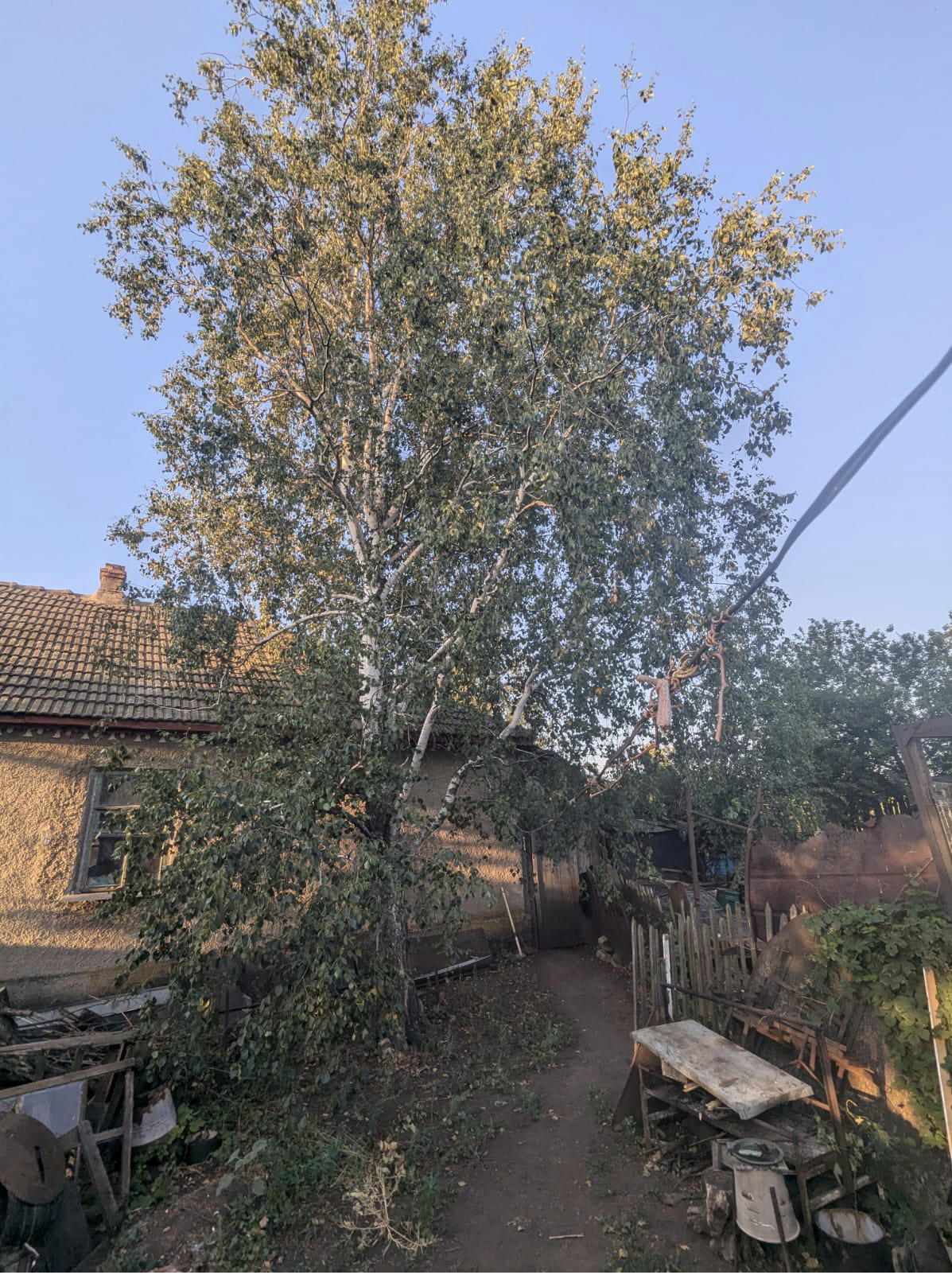
Figure 3.
The remaining birch near my grandmother’s house in Dobryanka (2020s). Author’s collection.
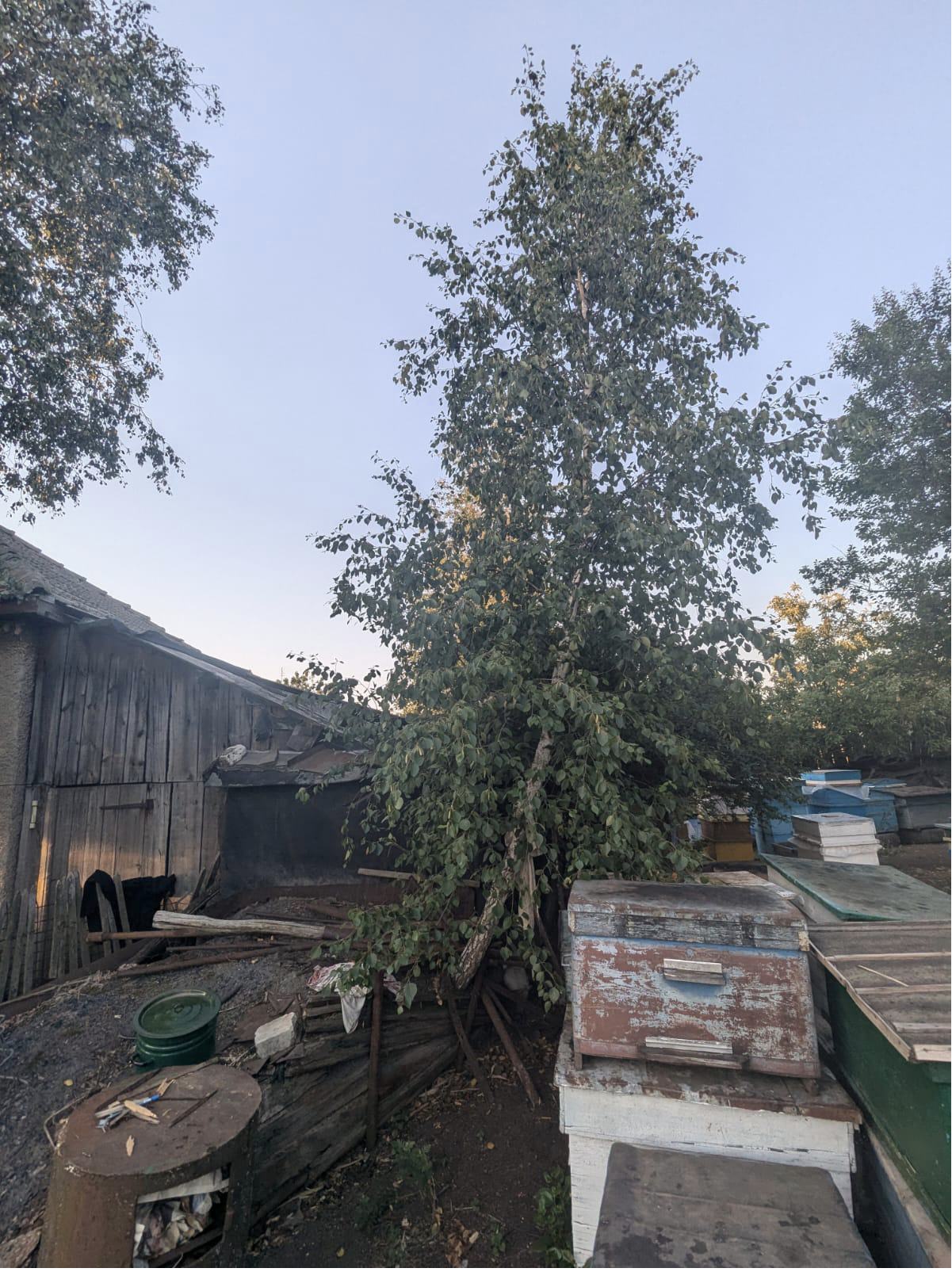
Figure 4.
Already considerably grown young birch on a pile of coal (2020s). Author’s collection.
Unfortunately, it has already been eleven years since my grandmother passed away, and ten years since I have been unable to visit Luhansk and my beloved village nearby. I cannot see my native land and our birches because Russia, once a good neighbour with many relatives, has turned into an insatiable occupier with many enemies. This aggressive country with its neo-imperial politics has taken my close people, home, friends, childhood and youth – I am able to save only memories. It is even hard for me to breathe when I think about the situation. However, the old and young birch trees near my grandmother’s house continue to grow in my memory. How I long to see and touch them again. It seems that this can calm my mind and heal the painful emotional wounds, although I am not ready to go to the ongoing war for this yet. I continue to arrange my life in Finland, developing my scientific career, with a feeling of guilt and an amputated part of my soul.
During my childhood, there was another birch tree besides those in my grandparents’ yards. I will call it a connecting tree. It was not one of my own, and I was in close proximity to this tree only a couple of times in my life, but it has since become significant to me. This birch grew in a forest plantation along the railway that connected Luhansk, Dobryanka, and Izvaryne, the last village on the border with Russia, near Donetsk. A local Hungarian-made train, legendary to me, ran along this railway. We called the train Diesel. In the nineties, when our car broke down and bus travel was expensive and irregular, Diesel was the most reliable transport to reach my relatives, both on my father’s side and my mother’s. There was only one train and route; the only difference was the duration of the journey.
My dad first showed me this birch tree from the train window. It was unique along the entire road, the only one with white bark that stood out in spring, winter and autumn among the planted maples, ash trees, oaks, robinias and elms. In the summer, when all the trees turned green, it was harder to notice this birch from the moving train. I only approached it a couple of times, as I mentioned above, when my dad and I were hunting in those places. But standing next to it, I did not feel anything unusual. Seeing this birch tree from the train, though, always meant that we were approaching Dobryanka, or it signalled that I would be in Donetsk in a couple more hours. I do not know what is happening with this tree now. It might no longer exist in reality, but it still plays an important role in my birch memory web.
Later in my life, more and more birches appeared. I have countless memories related to these trees and entire birch forests from the field practices in the East of Ukraine during my student years, as well as from Kyiv and its surroundings, and the Chernihiv region, where many important events of my adult life took place. Now, living in Finland, I am completely surrounded by birches (Figure 5), but am pleased when I encounter other types of trees. Nonetheless, my attachment to these white-bark trees remains unwavering. Returning to the birch leaf received during the retreat in Lapland, I realise that my childhood memories form the main veins of my web, while the memories from my adult life are the smaller venules within it.

Figure 5.
Birches near my rented apartment in winter time (Oulu, February 2023). Photo by author.
When the retreat session ended, I continued analysing my emotions and the workshop as a whole. I do not know exactly why our facilitator chose birch leaves for our work. Perhaps it was because these trees are more common around our retreat house in Finnish Lapland, in taiga or boreal forests as a whole. But it is also likely that he knew everyone originally from the Northern Hemisphere has memories connected with birch trees.
I try to think of other species of plants and animals, but none of them evoke such strong memories and emotions in me. While I could easily build memory webs with linden, lilac, walnuts, cows, sheep, goats, hares, and many other familiar trees, shrubs, herbs, birds and mammals, none have the same impact.
I remain shocked now because I had never thought before about how much information, memory and emotion from people with different backgrounds is preserved in biological species. This realisation could be an additional motivation to protect certain species, individual trees or even entire natural areas as carriers of memories for individuals or even generations.
If you think about the trees who have witnessed your life, they will trigger memories too, won’t they? A whole world of our history wrapped up in the existence of their branches.
ACKNOWLEDGEMENTS
I am especially grateful to Dr John Ryan for his editorial corrections of this essay as well as for his positive and motivational words during the preparation of this text. Also, I thank a lot the project ‘Gifts from the Sentient Forest: Communication and Collaboration between Trees and People in Northern Finland’, supported by Kone Foundation, for its invitation to take part in the mentioned retreat and to become a member of its cohort. It is pleasant to remember too the Biodiverse Anthropocenes Research Programme, supported by the Academy of Finland PROFI6 funding (2021–2026) (project number 336449), thanks to which I work in a creative and safe environment during the large-scale Russian invasion of Ukraine.
Mykyta Peregrym is a botanist with nearly 25 years of experience studying plant diversity, specialising in rare, endangered, and invasive species. His expertise extends to citizen science initiatives, biodiversity data collection, nature conservation and herbarium management. Most of his academic career was based in Ukraine, where he worked in prominent academic and university botanical gardens in Kyiv. He has also held international roles, including as a postdoctoral researcher in Hungary and a visiting researcher in Slovakia and Kazakhstan. Since December 2022, Dr Peregrym has been actively engaged in scientific and creative pursuits at the University of Oulu, Finland.
Emails: mykyta.peregrym@oulu.fi, mykyta.peregrym@gmail.com
1 A picture from Google Earth where even the stumps from our birches are no longer visible (August 2019): https://earth.app.goo.gl/?apn=com.google.earth&isi=293622097&ius=googleearth&link=https%3a%2f%2fearth.google.com%2fweb%2f%4048.32124571,39.88002859,174.07138062a,0d,81.82841692y,86.84676377h,77.00298792t,0r%2fdata%3dIhoKFnJVVjJBLWlySzQyaUY4LUZ2N19xd3cQAjoDCgEw